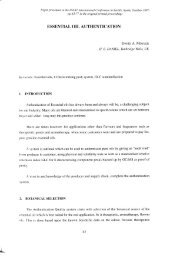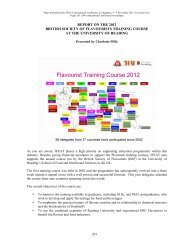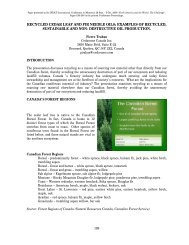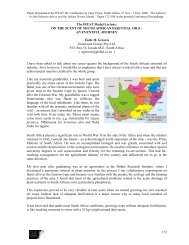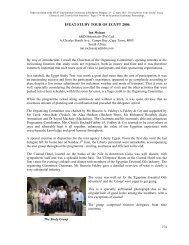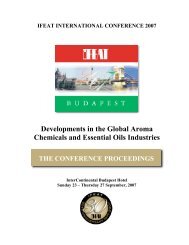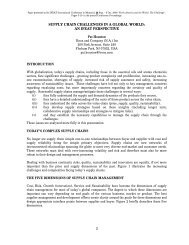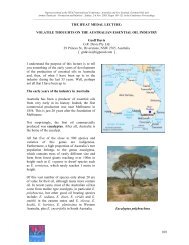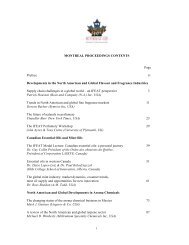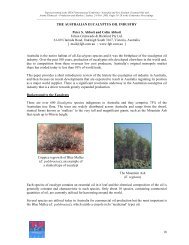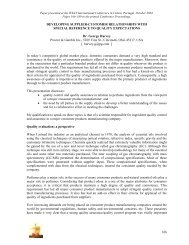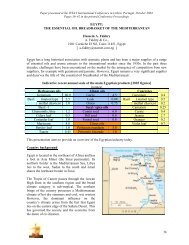WHY PERFUME PRODUCTS? - IFEAT
WHY PERFUME PRODUCTS? - IFEAT
WHY PERFUME PRODUCTS? - IFEAT
Create successful ePaper yourself
Turn your PDF publications into a flip-book with our unique Google optimized e-Paper software.
Paper presented at the <strong>IFEAT</strong> International Conference in Budapest, Hungary, 23 - 27 Sept. 2007 ‘Developments in the Global AromaChemicals and Essential Oils Industries’. Pages 157-166 in the printed Conference Proceedings.INTRODUCTION<strong>WHY</strong> <strong>PERFUME</strong> <strong>PRODUCTS</strong>?Dr. Tony CurtisUniversity of Plymouth Business School,Plymouth, Devon PL8AA, UKt.curtis@pbs.plym.ac.ukA successful product is an entity which customers perceive to meet and provide their benefit needs andwants. The entity may be a physical product, a service or a mixture of both. In the marketing of makeupit is said that ‘In the factory we make cosmetics, in the shop we sell hope.’ Products have featureswhich deliver benefits; we can view a product as an ‘input-output’ device. The inputs are the featuresthat are designed or formulated into the product. The outputs are the benefit sets that the customersand users need, want, expect, value and pay for (Figure 1).Figure 1 – Input-output model of productNot all customers are the same and different segments demand different benefit sets. In personal careproducts, manufacturers formulate different products for men and women. This process of dividing amarket into subsets is called market segmentation.MARKET SEGMENTATIONThe aim of market segmentation is to define a group of customers who have similar needs and aredifferent to other groups. The process has to be practical and the resulting segments should bemeaningful. It is easy to apply several segmentation processes and end up with many small segments.In most cases, it is not practical to market too many small market segments. The process ofsegmentation is not to be regarded as analytic and convergent. It is an open-ended process without aunique single right solution, just as in product design. The process does need analytic skills but theseneed to be directed in a creative problem-solving framework.157
Consumer market segmentation variables• Gender: many products need different variants for males and females e.g. perfumes andcosmetics.• Age: people have different needs and wants at different stages of their lives. Teenagers havedifferent cosmetic demands to older consumers.• Race: different cosmetics are required for different coloured skins e.g. pale skinnedEuropeans are more sensitive to UV radiation than people with darker skins.• Religion: religion affects a whole range of products such as food, drink, cosmetics andpersonal care.• Geographic: this not only includes issues such as country of residence but also otherapproaches e.g. city dweller as opposed to rural residence.• Personality and lifestyles: lifestyle affects the range of products people want e.g. sportsenthusiasts with ‘sport’ variants for personal care products.• Socio-economic groups: professional status and income affect some purchases e.g. moreeducated and higher earners tend to be more frequent customers for prestige perfumes andcosmetics.• Purchase occasion: some products are purchased at specific times of the year e.g. perfumes(duty free on holiday, Christmas and birthdays).• Consumption behaviour: a typical classification would be heavy, medium, light and nonuserfor a product e.g. frequent use variants of shampoos.The above is a starting prompt list. Variables may need to be interpreted for any given situation andnovel segmentation approaches will need to be devised. Figure 2 shows the process. Sometimes thesegmentation variables are rather simple and provide just a few relevant variables. Table 1 shows therange of products devised and issues that might be considered by a fabric-care formulation scientist.Figure 2 – The segmentation process158
Table 1 - Some Selected Segmentation of DetergentsStandard variable Interpretation CommentsGeographic Hard water and soft water area In hard water areas washing machines need to beprotected from scale build up from temporaryhardness (water from chalk and limestonesources).Out of town useIn rural areas, with septic tank use, formulationsmay need modification.InternationalThe popularity of various types of washingmachines varies from country to country (e.g. toploading against front loading automatic).ConsumptionSingles in studio apartments are Different sized packs.lighter users than large familiesBenefitsCleaning: food stains etc. are different Biological and non-biological products.PersonalityOther segmentationissuesMethod of washingto other soilCost: Heavy users on tight budgets(e.g. large families) need to haveeconomy of washing, professionalsingles not so concernedAllergies: Concern for allergicreactionsAppearance: Maintenance ofappearance of fabric: colourAppearance: Maintenance ofappearance of fabric: nature of fabricSome people just want to clean theirclothes; others are more concernedwith ecological issues. Lowtemperature also saves energy andcarbon dioxide emissionsHand washing, automatic machines,top loading machinesPremium products such as branded detergentpods and economy generic powders. Lowtemperature washing reduces costs.Low allergy, non-biological formulations;possibly without perfume.White fabrics may need bleach and opticalbrighteners. Coloured products may need ‘colourcare’formulations. Black fabrics can showpowder streaking, specially formulated liquidproducts.Cotton is different from wool and silk. Differentproducts needed for different fabrics.Low temperature and eco-friendly formulations.High foam detergents, formulated for handwashing, will be a disaster in an automaticwashing machine (it can flood the kitchen withsuds) and low foam products are needed.Detergent tablets and liquid pods.Ease of useSome people find measuring out aquantity of detergent irritatingPlace of wash Home, launderette and open air In developed countries small vending packs maybe needed for launderettes. In less developedcountries washing is often done by hand withbars of laundry soap.B2B applications Laundries form a different market Bulk deliveries.The Nature of ProductsProducts have a range of features and benefits. These can be defined as hygiene features andmotivating features. If the product has all the required hygiene features it has the possibility of159
entering the race. However this is like a ‘fun-runner’ in the London Marathon; there is not muchlikelihood of winning the race. Hygiene features are the core benefits provided by basic product(Figure 3). They are expected and, if given, no notice is taken of them. If they are not provided, thecustomer will disappear. A hotel will not advertise ‘All our rooms have beds’, this is expected. If thehotel advertised ‘Our rooms are very cheap, bring your own bed and sleeping bag’ they are not likelyto gain much business. A person does not buy a given car because it has four wheels and has an engineand provides transport. People expect more: air conditioning, in-car entertainment, satellite navigation,smart engine management system, good styling etc. The goal posts are always moving, last year’saugmented product will be this year’s expected product. If we want to be champions we had better bedeveloping the technologies to create the potential product. If we want to be a world-beater, blue-skyresearch will be needed to invent the technologies for the ideal product of the future.There is an interaction between the benefit needs of society for the ideal product and the enablingtechnologies. The new product development question is the ‘chicken and egg’ problem. Which comesfirst, the technology or the market identification of the benefit need? Which is more important? If wehave a benefit need and no technology we do not have a product. If we have a product but no need; wedo not have a product. To have a successful product we need enabling technologies and real demandfrom the market for the benefits: consider a double gate situation as found in some electrical circuits(e.g. relay logic systems); both gates have to be open for success. The creative process can start fromeither platform. A perceived market need can set off a search for the technology or a technologydeveloped for one purpose can be implemented to produce entirely new products. What is needed isthe way to link the benefit needs to the technical or engineering definition of the product; this isprovided by the Plymouth Model (Figure 5).Figure 3 – Levels of product from basic to idealPlymouth Model for the Architecture of ProductThe Plymouth Model provides a framework for the analysis of an existing product or a template todraw up a product innovation charter definition for a new product. The treatment below is given in thecontext of new product development. Prior to the application of the Plymouth Model the segmentation160
process should be completed. The needs of dissimilar segments are different and these variations needto be reflected in the marketing mix, for each of the selected target market segments.Market PositioningEarlier in this paper we noted that for white cotton the proposition, the positioning statement, for adetergent might be ‘Washes whiter.’ For a low temperature product, designed for coloured specialfinish fabrics, the positioning statement might be ‘Colour care, easy iron.’ (Figure 4) The formulationof the product will need to be different to reflect the different functional (benefit set) needs andproduct positioning.Figure 4 Product positioning mapAlthough this model is simple it does allow the product proposition to be compared with that of otherproducts in the market place. It is one tool for new product visioning. If the spread of products leaves ahole in the cover of the domain of all possible market positioning, then this might indicate that therewas a gap in the market. Market leader companies are always attempting to find good market gaps andthen be first to develop products for them. Another strategy, followed by the market followers, is tocreate ‘Me too’ products. Here, the engineer or formulation scientist re-creates a product with verysimilar or even identical market positioning. The trick to this process is to find the ‘right’ variables forthe product positioning variables. Figure 4 shows this process in two dimensions. Segmentationvariables form a multi-dimensional space and products can be mapped in a multidimensional space. Inthe detergent example two additional vectors might be ease of use and degree of eco-friendliness.161
Figure 5 - The Plymouth Model of ProductHaving defined the market segment and the positioning of the product in the segment the next stage isto complete the attribute analysis. For a market driven process this should get started with the analysisof the benefit set. There are two types of benefits: intangible and tangible (Figure 5).Intangible BenefitsMany of the products we buy have an aesthetic component. The textile technologists, working with thefashion designers, are creating clothes that are fashionable and make people feel good. To maintain thefabric in tip-top condition a good fabric care system is needed (detergent and conditioner) withappropriate perfumes. In the levels of product model (Figure 3) we largely concentrated on physicalfeatures and performance. However, for many products, a significant proportion of the benefit set is inthe intangible benefits. It may be on these intangible benefits that the business is won or lost. Theperfumed candle for a romantic dinner for two is about creating a sense of occasion with anappropriate ambiance. The product packaging will not announce ‘As effective as a 20 watt electricbulb but only 10% as efficient and a great fire hazard.’ It is more likely to say ‘Relaxing and romanticscent of tropical ylang, jasmine and sensual sandalwood.’Often, successful marketing communications will be focusing on the intangible benefits. The oldslogan in the UK for ‘Colgate [toothpaste] ring of confidence’ was focusing on self-assurance,coolness and social acceptability. Deep in the small print you might find ‘kills the bacteria that causebad breath.’ Marketing it as ‘disinfectant for the mouth’ is not likely to hit the success button.Although we are not able to measure 21 litres of confidence, 12 kilograms of love, 33 metres of162
eassurance, or 60 decibels of compassion; these are some of the most important things in our lives.Products that get us to deliver these benefits are more likely to be purchased.Tangible BenefitsThese are the actual physical things we wish the product to deliver. In some ways the process can beregarded as mission aims and objectives, for the product innovation charter. The mission is thedelivery of the intangible benefits and the aims and objectives of the product are the explicit,measurable outcomes needed. As such, tangible benefits should be expressed as measurable outcomes.This is important, as we need to evaluate performance, performance evaluated against the tangiblebenefit objectives we have set ourselves. This can be cleaning power of a detergent powder,substantivity of a hair conditioner or uniform emanation of an air freshener.Feature AttributesHaving defined what the product has to achieve, the scientist and technologist can use these as designparameters for the product innovation charter. The creative process can then be sought to find the mosteffective and efficient design and formulation solutions. This might be organic essential oils for afashion fragrance, natural active ingredients for a cosmetic or even innovative packaging (e.g. ‘ToiletDuck’ in the UK).Signal AttributesIn many cases the core benefit of the product is a hygiene factor. All shampoos should clean the hair.For many household and personal care products a desired intangible benefit is ‘well-being’. We do notassociate well-being with the aroma of half eaten pizza, stale beer and cigarette smoke, in the partyroom, the morning after the party. Concepts of ‘fresh as an Alpine spring meadow’ are more likely tobe the order of the day. A detergent is odourless and in any case it is rinsed away (we hope!) at the endof the cleaning process. The vast majority of household and personal care products are fragranced.How do I know the room is clean and get the sense of wellbeing? Because it smells clean, just like anAlpine meadow in spring. Other elements of the product can help the product to communicate. Colour,texture, shape, feel and appearance can all assist the marketer developing working on new products toget the product to ‘signal’ (communicate) its intended market positioning. In the UK an antidandruffshampoo may be fragranced to have a ‘medicated’ type odour and a pale blue colour.Some aspects of odour perception and communication are part of people’s biological makeup e.g. thesmell of burning is a universal communication of potential danger. Other aspects are part of people’scultural heritage. Just as with food there are different culture implications and uses of perfumes andperfumed products.The biology of odour perception is different to other senses. Odour sensations are transmitted to thelimbic system. This area is considered to also be involved with feelings, moods, emotions, sexualbehaviour and memory. Laboratory experiments have demonstrated that odours can affect mood andtrigger memories. The developing science has been called ‘aromachology’. The bottom line formarketers is that odours provide a powerful, non-verbal, channel of communication with the ability toaffect moods and emotion. With a hair conditioner the advertisement is seen occasionally and for afew seconds. The user sees the pack every time the product is used. The odour is perceived in thewashing process but the fragrance is often substantive (designed to remain on the hair) so the hairsmells ‘right’ for the whole day. In the branding of consumer products packaging and signal attributesare vital aspects of the integrated communications strategy.163
A practical illustration is in how appropriate perfumes can help marketer’s position bath and showerproducts. Many bath products (e.g. foam baths) are based on the platform of ‘relaxing’. Have you hada bad or stressful day? Half an hour in an aromatherapy bath is the ideal de-stressing programme.Many shower products are platformed on ‘invigoration’ and get up and go!’ Different fragrances in theproducts can help signal this type of product positioning. For ‘relaxing’ the claim might be ‘containsrelaxing aromatherapy oils’. For ‘Get up and go!’ the product might have ‘Invigorating citrus oils’.These messages may be culturally dependant and detailed knowledge is needed on different markets.Moreover these issues, as with other consumer products, change with time. 50 years ago few homes inthe UK had a shower, now the majority of homes have a shower. In the UK hand bar soap is in PLCdecline with liquid hand wash products gaining market share. This is not true in all countries wherehand soaps are still in PLC maturity. A major activity in creative perfumery houses is the marketresearch and intelligence to understand the different demands of various markets and how these arechanging with time.PerformanceOne important rule of science is: ‘to control, you have to measure.’ In setting the desired tangiblebenefits we should express these in ways that can be quantified or assessed. Simple parameters such astemperature can be easily measured but products often throw up more challenging issues. A hairconditioner may claim ‘easy comb’. Just what does this mean and how do you measure it? Cosmeticchemists have come up with a solution. Wash standard swatches of hair under standard test conditionswith the test formulations and the control standard. Attach the test swatch to a frame and insert acomb, connected to a force measuring device; then measure the force needed to move the combthrough the hair. The cosmetic scientist then has a set of benchmarked figures to support the claim‘easy to comb’ and can set about improving the product performance even further, the feedback loop iscompleted.What are needed are measures and estimates of performance that indicate the products performance inthe customer’s end use situation with methods that indicate the probable level of customer satisfactionwith the products performance. To set a tangible benefit aim without setting standards and devisingmethods of estimation is a complete waste of time.Legal ConformanceConsumers demand products that are safe, want to exercise choice and need information (the Kennedyrights). To satisfy these public demands there is a tangle of laws. These may be specific aboutmaterials that may not be used (e.g. IFRA banned perfume ingredients). Regulatory compliance is amajor demand on technical staff. Product descriptions have to give specific information, often usingvery prescribed and detailed protocols (e.g. perfume, cosmetic, food and drink labelling). In the UK asmall specialist craft producer of ‘home made’ ice cream ran into legal problems with their ‘Rum-n-Raisin’ ice cream, made with real rum. As this contained over 0.5% alcohol a ‘Licence to sell alcohol’was required. The licensee had to attend a specified training course (normally designed for publicans)and the product could only be sold to people over 18 (bring your passport to buy an ice cream). This isa particular problem with new classes of products and considerable legal/technical judgement may beneeded; just when does a food become an alcoholic drink?164
Account ConformanceIndividual companies may have their own specific requirements. Some cosmetic companies want tomake the claim that their product contains no animal derived products, so this may restrict the use ofsome ingredients (e.g. should bees wax be classified as an animal derived product?). A key area forfood technologists is the concern with healthy eating. ‘Junk’ food is perfectly legal. Simple rules canbe perverse; ‘Let us ban all high fat foods’ clears the cheese counter for you. Some considerabledebate is needed between the supplier and the customer company to get sensible interpretations andsuitable re-formulated products (e.g. ‘bad’ hydrogenated fats eliminated, low salt recipes etc.). In theUK some major supermarkets are moving to more demands for ‘fair trade’, ‘natural’, ‘organic’ claimsfor their product ranges. A difficult area recently has been the request for ‘non allergic fragrances’,clients not fully understanding the issues. The industry is working towards developing the level ofunderstanding of these issues with manufactures and retailers of fragranced products.Supporting ProductsSystem ‘components’ have to integrate in the customers’ end use situation. A washing machine is, inthis sense, not a complete washing system; to function the machine has additional needs: electricity,hot water, cold water, detergent, bleach (in some countries liquid bleach is added in washing whites)and fabric conditioner. When liquid detergents were first introduced to the UK market the machineswere not designed for this type of formulation. The improvised solution was the ‘detergent ball’, to befilled up with the liquid formulation and added into the wash in the drum. The performance ofperfumes in wash products has to be evaluated in the appropriate washing machines. In thedevelopment of new products and in moving into new international markets it is essential that thecustomer has access to these supporting products that are necessary for the actual performance of theproduct to deliver the benefit. Poor quality in any part of the system will cause problems.ServiceMany products need services. Another company may provide these; in this case they should beconsidered under supporting products (e.g. electricity and water supply for a washing machine). Asignificant part of the creative perfume or flavour house is the provision of technical service.Product MixThis is the range and depth of products to be offered. A hair care company might focus on a specificproduct segment or provide a full range (hair colour, permanent wave, shampoo, conditioner etc.); thisis the product range. Within a specific product group a company may offer a single variant (littleproduct depth) or and number of different offerings (e.g. different fragrance variants for a fabricconditioner).165
Table 2 Summary of the Plymouth Product ModelPlymouth ModelelementAttributesMarket positioningIntangible benefitsTangible benefitsFeature attributesSignal attributesPerformanceComplianceLegal conformanceAccount conformanceExtensionComplementary productsServiceRange and depthComments and selected examplesWhat is the proposition being made to the customers and users in the target segment (thisprocess must be repeated for each market segment) e.g. Up-market, down-market, easyto use, advanced eco-friendly etc.Love, security, status, self-confidence, freedom, well-being, belonging, excitement,comfort, relaxation etc. Things that are important to the buyers and users but may not bemeasured in the normal sense; we have yet to devise the sex-meter.Hair shine (hair conditioner), clean clothes etc.The precise formulation or product design elements. Can include materials ofconstruction, manufacturing process and sources of raw materials e.g. organic,sustainable, fair trade etc.Colour, texture, odour, sound, shape etc can all signal properties. Strawberry ice-creamwill be pink, not green. These are elements that are designed or built into a product toallow the product to communicate.The methods of test to measure the products ability to deliver the tangible benefits e.g.stain removal measurements for a detergent, substantively for a hair conditionerfragrance etc.Labelling, ‘must not haves’ (e.g. banned food additives, IFRA banned fragranceingredients), ‘must haves’ (e.g. tamper evident packs for food, correct labelling), safetystandards etc.Issues that are not legal requirements but have become demanded by specific accounts.Sometimes these are rather specialist (e.g. Kosher compliance for a manufacturer of foodproduct for the Jewish market) or more general (e.g. ISO 9000 compliance for suppliersas a quality audit requirement). In the briefing process it is important these accountconformance requirement (e.g. ‘must haves’ & ‘must not haves’) are known to the NPDteam, good understanding of the purchasing company’s DMU is essential (e.g.companies demanding organic, fair trade essential oils in their products).It is essential to take a systems view of a product. Most products are used in conjunctionwith other products and services. The complete system must deliver the expectedbenefits to the required standard or you do not have a product. That new washingmachine is a bit of a dead duck if the detergent foams too much.Typical services are: design, technical support, installation, training and maintenance.Service is an important element of the total package from the creative flavour orperfumery house.Product range: the number of different lines that the company decides to make. Does amanufacturer of cosmetics (benefit definition of business: beauty) also market hair careproducts?Product depth: the number of different sub-variants of the product that the companydecides to offer e.g. sizes, thickness, flavours, colours, perfumes etc.References1. Curtis, T. (2008), ‘Marketing for Engineers, Scientists and Technologists’, Wiley (in press)2. Curtis, T., Williams, D. (2001), ‘An Introduction to Perfumery’, 2 nd Edition, Micelle PressDr. Tony Curtis worked for Bush Boake Allen for 24 years in various technical roles.He has been teaching Marketing and Aroma Trades Studies at the University ofPlymouth for 17 years. He gained his PhD from University College, London insesquiterpene chemistry. He is a Fellow of the Royal Society of Chemistry, Fellow ofthe Chartered Institute of Marketing, Member of the Society of Cosmetic Scientistsand Honorary Member of the British Society of Perfumers.166



